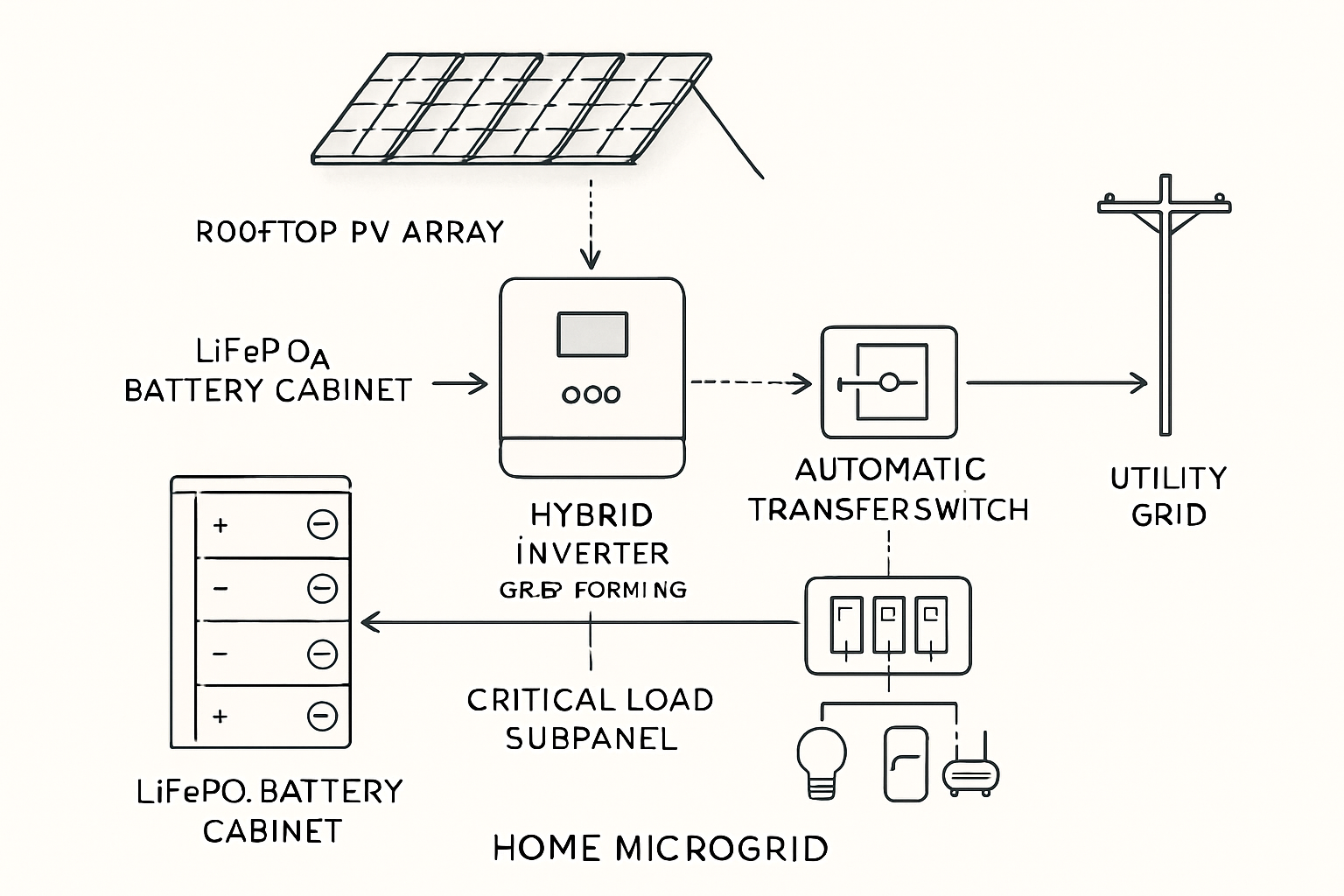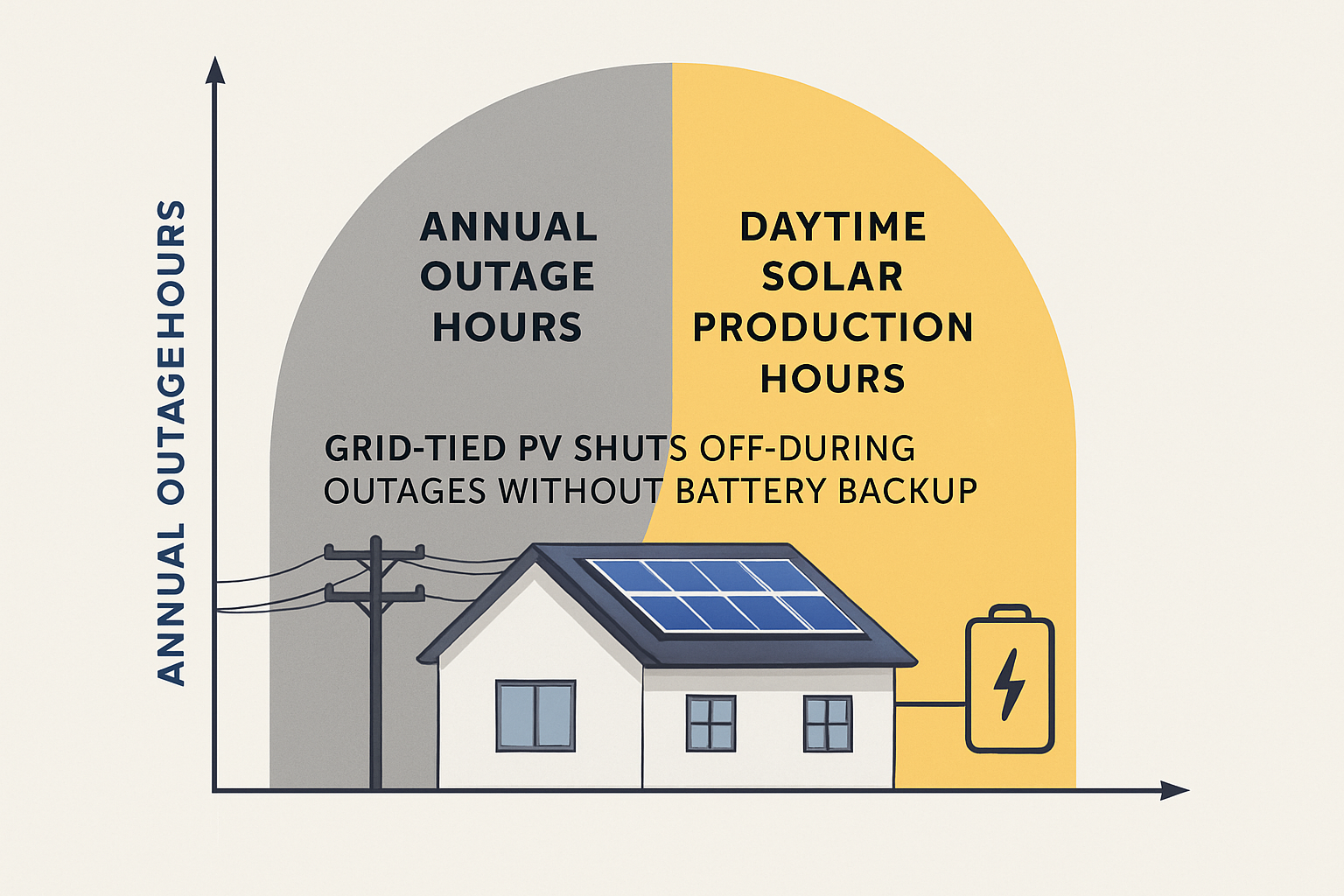Grid‑tied solar alone does not keep lights on during outages. Most rooftop systems shut down to protect line workers and equipment. A hybrid energy storage system (ESS) solves this by safely islanding the home, using batteries and a hybrid inverter to create a stable mini‑grid. This ESS case study shows how a typical family maintained critical loads through a multi‑day grid failure, followed by clear technical takeaways for blackout resilience.

Why grid‑tied PV shuts off in blackouts
Standard grid‑connected inverters must stop exporting power during outages. This is called anti‑islanding protection. Without it, a solar array could energize local lines and pose a shock risk to utility crews or damage equipment. The U.S. Department of Energy notes that most grid‑tied systems without batteries automatically shut down during utility interruptions for safety reasons, and a battery‑backed or hybrid configuration is required for backup power (source: Energy.gov – Planning a Home Solar Electric System and Energy.gov – Solar Battery Systems).
Hybrid ESS inverters include an automatic transfer switch (ATS) and can form a local grid. They isolate the home from the utility, stabilize frequency and voltage, and coordinate solar and battery dispatch. This allows solar generation to continue supplying the house while charging the battery during daylight, all without back‑feeding the utility lines.
The home and the outage: a real‑world run
Household profile
This case study reflects a four‑person suburban home with typical daily use. The owners sought solar power outage solutions that prioritize fridge, lighting, communications, and HVAC. They selected a hybrid ESS to achieve blackout resilience and reduce peak bills.
- PV array: 6.6 kW (18 x 370 W modules)
- Hybrid inverter: 8 kW continuous, 2x surge for 10 seconds
- Battery: 20 kWh LiFePO4 (two 10 kWh modular packs), 90% usable capacity
- Critical loads subpanel: fridge, gas furnace blower or heat pump (low‑power mode), Wi‑Fi, well pump, selected outlets and lights
- Wiring: DC‑coupled PV to hybrid inverter, ATS for safe islanding
Outage event
A severe storm caused a 54‑hour outage. Weather was mixed: sunny periods with intermittent cloud cover. The system was commissioned with batteries at 100% state of charge (SOC) as the storm arrived.
Critical loads and daily energy budget
| Load | Power (W) | Hours/day | Daily energy (kWh) | Notes |
|---|---|---|---|---|
| Refrigerator | 120 (avg) | 24 | 2.9 | Compressor cycling |
| Heat pump (eco mode) or furnace blower | 600 | 4 | 2.4 | Thermostat setback |
| Wi‑Fi + networking | 20 | 24 | 0.5 | Backups and remote work |
| LED lighting (whole home, selected) | 60 | 6 | 0.4 | Task lighting only |
| Well pump / water circulation | 700 (surge), 200 (avg) | 1 | 0.2 | Intermittent |
| Outlets (phone/laptop charging, TV) | 150 (avg) | 4 | 0.6 | Managed use |
| Misc. standby | — | — | 0.5 | Measured baseline |
| Total critical load | — | — | 7.5 kWh/day | Backup target |
Energy flow over 54 hours
With a 20 kWh LiFePO4 battery (≈18 kWh usable at 90% DoD) and 6.6 kW PV, the home targeted daytime self‑supply and nighttime battery use. Load management kept peak draw within inverter limits. The hybrid ESS maintained stable 230/120 V split‑phase output with frequency‑watt control to prevent PV over‑generation during full battery conditions.
| Period | Battery SOC start | PV generation | Critical load | Battery SOC end | Notes |
|---|---|---|---|---|---|
| Night 1 (12 h) | 100% | 0 kWh | 4.0 kWh | 78% | Fridge, networking, limited lighting |
| Day 1 (12 h) | 78% | 24 kWh | 3.5 kWh | 98% | PV meets loads, recharges battery |
| Night 2 (12 h) | 98% | 0 kWh | 4.2 kWh | 75% | Colder night, slightly higher HVAC use |
| Day 2 (12 h) | 75% | 21 kWh | 4.0 kWh | 92% | Clouds reduce PV; ESS curtails PV at high SOC |
| Night 3 (6 h) | 92% | 0 kWh | 2.2 kWh | 80% | Grid restored after 54 hours total |
The home maintained comfort, refrigeration, internet, and basic heating with >20% SOC headroom throughout. This aligns with the Energy Information Administration’s typical household usage context: U.S. homes average about 886 kWh per month (≈29 kWh/day), so a critical‑loads budget near 6–10 kWh/day is realistic under conservation (EIA – Average Residential Electricity Use).
Technical notes that made the difference
Hybrid inverter and anti‑islanding
The inverter’s ATS isolated the home in under 20 milliseconds, preventing appliance resets. Frequency‑watt and volt‑VAR functions stabilized PV output during variable cloud cover. The unit supported 2x motor‑start surge for the well pump. This behavior aligns with established grid‑forming practices highlighted in IEA’s Electricity Security material, which emphasizes the role of storage and fast inverters in maintaining reliable supply with variable renewables.
Battery chemistry choice: LiFePO4
LiFePO4 offers strong thermal stability, long cycle life, and usable depth of discharge suitable for home energy storage. Typical specifications include:
- Cycle life: 4,000–6,000 cycles to 80% capacity under moderate conditions
- Usable DoD often 90–95% with managed current and temperature
- High round‑trip efficiency (typically 94–97%)
Global assessments from IRENA and updates in IRENA’s cost reports show steady declines in storage costs and strong performance improvements, which enhances the value case for home energy storage.
DC‑coupled vs. AC‑coupled
- DC‑coupled hybrid ESS: PV connects on the DC side, improving charging efficiency and enabling solar to charge batteries during outages without double conversion.
- AC‑coupled retrofits: Keep existing grid‑tied PV inverters, add a battery inverter. Simpler upgrades but can incur extra conversion losses and coordination complexity.
Either architecture can maintain blackout resilience if the system can form an island and manage PV safely during grid loss. Energy.gov notes that systems intended for backup must be designed specifically for this operating mode (Energy.gov – Solar Battery Systems).
Sizing guidance for blackout resilience
Quick sizing formula
Battery capacity (kWh) ≈ Critical load (kW) × hours × (1 / DoD) × (1 / inverter efficiency)
- Example: 0.5 kW average critical load × 16 h night × 1/0.9 DoD × 1/0.95 ≈ 9.4 kWh
- To ride through clouds, add daytime autonomy margin and weather buffer (20–30%).
Backup hours vs. battery size (typical home)
| Battery size (usable kWh) | Avg. critical load (kW) | Approx. backup hours (no PV) | With 6 kW PV daytime |
|---|---|---|---|
| 10 kWh | 0.5 | ~20 h | Indefinite in sunny periods; nights covered |
| 15 kWh | 0.6 | ~25 h | Improved cloudy‑day performance |
| 20 kWh | 0.7 | ~30 h | Better multi‑day resilience |
For homes without space or budget for large batteries, pairing moderate storage with thoughtful load triage and a hybrid inverter still delivers strong blackout resilience.
Performance, safety, and economics
Operating strategy
- Normal days: time‑of‑use shifting and peak shaving to lower bills.
- Storm alert: charge batteries to 100% and pre‑cool or pre‑heat the home.
- Outage mode: prioritize critical loads, cap HVAC power, and keep some SOC reserve for overnight.
IEA notes that flexibility options such as storage improve reliability as solar share grows (IEA – Electricity Security). This hybrid ESS strategy supports both reliability and daily bill savings.
Safety and compliance
- Follow local electrical code and interconnection rules for anti‑islanding and transfer equipment.
- Use batteries with certified battery management systems and appropriate enclosures.
- Include rapid shutdown for rooftop arrays where required.
- Plan ventilation and clearance per manufacturer and code.
Energy.gov’s consumer resources highlight the importance of working with qualified installers and ensuring systems are designed for backup operation (Energy.gov – Planning a Home Solar Electric System).
Value case
Solar LCOE has fallen dramatically, improving the economics of pairing PV with storage. IRENA reports sustained declines in PV costs through 2021, making integrated systems more accessible (IRENA – Renewable Power Generation Costs). While outage frequency varies by region, even a few hours of interruption can risk food spoilage, lost work time, and comfort issues. Storage provides resilience plus tariff optimization in markets with time‑varying rates.
Practical steps to replicate this success
Site and load assessment
- List critical loads and their power ratings; target 6–10 kWh/day for backup.
- Confirm roof or ground space for 5–8 kW PV and identify shaded areas.
- Measure or estimate standby loads to avoid unexpected overnight drain.
System selection
- Hybrid ESS integrating LiFePO4 battery, hybrid inverter, and solar panels reduces design risk and speeds commissioning.
- Modular batteries (e.g., 5–10 kWh blocks) allow future expansion.
- Inverter continuous power should exceed combined critical loads by a safe margin; verify motor surges.
Installation and commissioning
- Use a critical loads subpanel and label circuits clearly.
- Set charge targets: 100% SOC ahead of storms; reserve SOC in daily use.
- Test islanding: simulate a grid outage to validate transfer time and load priority.
Operations and maintenance
- Keep firmware updated for inverter and BMS.
- Periodically test backup function and review SOC logs.
- Maintain ventilation clearances and check torque on terminals as specified.
How our solutions map to these needs
Drawing on years in the solar and storage industry, the product lineup focuses on reliable, scalable home energy storage:
- LiFePO4 lithium battery: high performance and safety for daily cycling.
- Integrated ESS storage: hybrid inverter, lithium battery, and solar panels designed to work together for seamless backup.
- Off‑grid solar packages: for remote homes, farms, and cabins.
- Solar inverters: efficient DC‑to‑AC conversion with grid‑forming capability in backup mode.
The shared goal: help households achieve energy independence and blackout resilience without overcomplicating design or maintenance.
Key takeaways
- Standard grid‑tied PV shuts off in outages due to anti‑islanding safety requirements (Energy.gov).
- A right‑sized hybrid ESS can carry critical loads for multiple days, especially with daytime solar recharge.
- LiFePO4 batteries and hybrid inverters provide safe, efficient, fast‑transfer backup.
- Data‑driven sizing and a disciplined critical‑loads plan matter more than headline kWh alone.
- Global cost trends for PV and batteries strengthen the long‑term value of home energy storage (IRENA), while energy security frameworks recognize storage as a resilience tool (IEA).
References
- According to Energy.gov – Planning a Home Solar Electric System, most grid‑tied PV systems without batteries do not operate during power outages.
- Energy.gov – Solar Battery Systems provides guidance on battery‑ready systems for backup.
- EIA – How much electricity does an average residential customer use? reports average U.S. residential usage of about 886 kWh/month in 2022.
- IEA – Electricity Security discusses the role of storage and flexibility for reliable power systems.
- IRENA – Renewable Power Generation Costs in 2021 documents ongoing cost declines in solar and related technologies.





Leave a comment
All comments are moderated before being published.
This site is protected by hCaptcha and the hCaptcha Privacy Policy and Terms of Service apply.